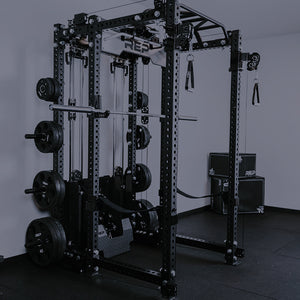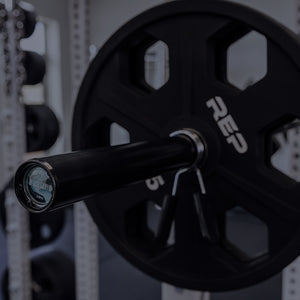Strength sports has its own language, one with a ton of acronyms.
It’s not quite as complex as learning French (and definitely easier to spell). But whether you’re new to lifting or an experienced athlete who prefers to lift rather than talk about the lifts, sometimes you’ll run across a term you’ve never heard before.
Enter: The Strength Sports Dictionary.
Here are some words you might not know but will commonly find in the gym, in gym circles, or in lifting content.
There will be a quiz about these terms on Friday.

1RM: Short for “one-rep max,” referring to the maximum amount of weight you can move in a lift for one single rep.
AMRAP: This stands for “as many reps as possible” -- with good form.
ATG: Used to describe a deep squat, typically below parallel.
Barbell shaft: The main part of the barbell that you grip onto. Shafts can be different diameters and have varying knurling and markings.
Barbell sleeve: The ends of a barbell where you load the weights. Sleeves may rotate or not.
Bearing sleeves: Ball or needle bearings allow for a faster, smoother, quieter barbell spin and have a more reliable turnover for maximum loads, which is a better fit for Olympic-style lifts.
Box: Slang for a CrossFit gym.
Bumper plates: Weight plates made from high-density rubber designed to protect the floor, bar, plates, and lifter if they are dropped.
Bushing sleeves: Bushing sleeves are efficient for powerlifting movements, which are slower and more strength focused.
Camber: A bend at the end of a specialty barbell that drops the plates so they sit lower than a straight barbell.
Cerakote: A special coating (over metals) that is resistant to rust and abrasion. It can come in different colors.
Collars: A clamp/spring clip you put on the sleeve to hold the weight plates in place.
Concentric/eccentric: The two parts of a lift. The concentric refers to the lifting (when you push against the weight to move it) and the eccentric refers to the lowering portion of the move.
Crossmembers: Horizontal, heavy-duty beams bolted onto a power rack that add stability and versatility.
Crumb rubber: Recycled rubber used to make durable bumper plates with softer bounce. Here’s an example of crumb rubber bumper plates.
Deficit: Where the range of motion of a lift is lengthened. For example, a deficit deadlift would be performed standing on an elevated surface, like a weight plate.
DOMS: This stands for “delayed onset muscle soreness,” referring to the soreness you feel one to three days after a tough workout.
Drop set: When you do an exercise to muscle failure, and then drop the weight and immediately perform it again with less weight.
EMOM: Stands for “every minute on the minute.” Typically, you’ll choose a set number of reps of an exercise to complete within a minute and rest for the rest of the time. When the clock hits the next minute, repeat.
Erg: Erg is short for “ergometer,” which measures the word done on an exercise machine, such as a rower or skier.
FID: FID stands for flat/incline/decline on an adjustable bench.
HIIT: This stands for “high-intensity interval training,” a type of training where you do short periods of intense exercise alternating with short periods of rest.
J-cups: The hooks that attach to a power rack or rig that hold the barbell in place at a certain height when you’re not using it.
Knurling: The crosshatch pattern on the shaft that increases the grip of your hands on the bar.
Knurl markings: Small, smooth marks in the knurling on a barbell to help lifters set up properly for the lift and provide a visual for even hand placement on the barbell.
Knurl style: There are three types of knurl styles: hill, volcano, and mountain. Hill-style knurling is the most passive and won’t dig into your hands. It is good for training bars. Mountain is the most aggressive knurl style. You’ll see this style with powerlifting barbells to provide the best grip for your one-rep maxes. The most common knurl style you’ll see on a lot of REP’s weightlifting and mixed-use bars is volcano. Volcano knurling has a good amount of grip without tearing up your hands.
Plyo: Short for “plyometrics,” a type of training that uses force and speed explosively to build power. For example, box jumps.
Powder coating: A coating sprayed onto gym equipment that creates a hard, more durable finish than standard paint.
Pulley ratio: How the weight on a cable machine feels. A 1:1 pulley ratio means 20lbs feels like 20lbs. A 2:1 pulley ratio means 10lbs feels like 10lbs. The 2:1 ratio is ideal for explosive, quicker pulley movements.
PR or PB: Stands for “personal record” or “personal best.”
RDL: Short for “Romanian deadlift,” a type of deadlift with a straighter leg position, focusing on the hip hinge, without letting the bar touch the floor. Start in the standing position, holding the bar on front of the hips, rather than pulling from the floor, like a regular deadlift.
RIR: A weightlifting term that means “reps in reserve” to help describe how hard a set was. In other words, when you finished the set, how many reps do you think you could have still done?
ROM: Stands for “range of motion.” This refers to completing the exercise to the farthest point of motion that is still beneficial.
RPE: Rate of perceived exertion, a 1-10 scale used to describe how difficult a set felt.
Safeties: Pins or straps on a power rack that can catch the bar if you miss a lift.
Super set: When you alternate two different exercises one after the other with no break in between, followed by rest.
Tabata: A type of training where you do 20 seconds of an exercise followed by 10 seconds of rest, and repeat for eight total rounds (four minutes total).
Tensile strength: In lifting, the tensile strength is the breaking point of a barbell. It’s rated in pounds per square inch (PSI). A higher PSI is stronger.
Tolerance: The measurement of accuracy of a weight. The lower the tolerance, the more accurate the actual weight is to the stated weight.
TUT: Short for “time under tension,” referring to how long you put your muscles under resistance.
Uprights: The vertical posts on a power rack.
WOD: An acronym for “workout of the day,” commonly used with CrossFit.








